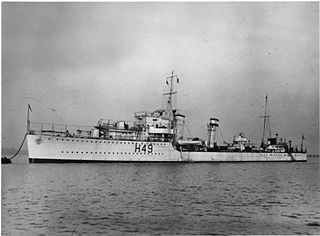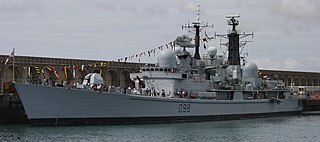
HMS Invincible was the Royal Navy's lead ship of her class of three light aircraft carriers. She was launched on 3 May 1977 as the seventh ship to carry the name. She was originally designated as an anti-submarine warfare carrier, but was used as an aircraft carrier during the Falklands War, when she was deployed with HMS Hermes. She took over as flagship of the British fleet when Hermes was sold to India. Invincible was also deployed in the Yugoslav Wars and the Iraq War. In 2005, she was decommissioned, and was eventually sold for scrap in February 2011.

HMS Illustrious was a light aircraft carrier of the Royal Navy and the second of three Invincible-class ships constructed in the late 1970s and early 1980s. She was the fifth warship and second aircraft carrier to bear the name Illustrious, and was affectionately known to her crew as "Lusty". In 1982, the conflict in the Falklands necessitated that Illustrious be completed and rushed south to join her sister ship HMS Invincible and the veteran carrier HMS Hermes. To this end, she was brought forward by three months for completion at Swan Hunter Shipyard, then commissioned on 20 June 1982 at sea en route to Portsmouth Dockyard to take on board extra stores and crew. She arrived in the Falklands to relieve Invincible on 28 August 1982 in a steam past. Returning to the United Kingdom, she was not formally commissioned into the fleet until 20 March 1983. After her South Atlantic deployment, she was deployed on Operation Southern Watch in Iraq, then Operation Deny Flight in Bosnia during the 1990s and Operation Palliser in Sierra Leone in 2000. An extensive re-fit during 2002 prevented her from involvement in the 2003 Iraq War, but she was repaired in time to assist British citizens trapped by the 2006 Lebanon War.

HMS Manchester was a Type 42 destroyer in the 5th Destroyer Squadron of the United Kingdom's Royal Navy. She was laid down in 1978 at Vickers Shipbuilding and Engineering, launched in 1980, commissioned in 1982, and decommissioned on 24 February 2011.

HMS Northumberland is a Type 23 frigate of the Royal Navy. She is named after the Duke of Northumberland. She is the eighth RN ship to bear the name since the first 70-gun ship of the line in 1679, and the ninth in the class of Type 23 frigates. She is based at Devonport and is part of the Devonport Flotilla.

HMS Cumberland was a Batch 3 Type 22 frigate of the British Royal Navy. She was launched in 1986 and commissioned on 10 June 1989. The frigate was on station during the First Gulf War and was part of the Devonport Flotilla based at Devonport Dockyard. Cumberland was decommissioned on 23 June 2011.

HMS Glasgow was a Type 42 destroyer of the Royal Navy. The last of the Batch 1 Type 42 destroyers, Glasgow was commissioned in 1979. The destroyer fought during the Falklands War, and on 12 May 1982 was damaged by a bomb from an Argentine A-4 Skyhawk. Glasgow was part of the Royal Navy’s 3rd Destroyer Squadron along with HMS York, HMS Edinburgh and HMS Liverpool. The 3rd Destroyer Squadron was based in Rosyth during the 1980s and early 1990s before being moved to Portsmouth when Rosyth Dockyard was privatised and re-purposed. The destroyer was decommissioned in 2005 and was broken up for scrap in 2009.

RFA Grey Rover (A269) was a Rover-class small fleet tanker of the Royal Fleet Auxiliary (RFA). She was decommissioned in 2006.

HMS Glamorgan was a County-class destroyer of the Royal Navy with a displacement of 5,440 tonnes. The ship was built by Vickers-Armstrongs in Newcastle Upon Tyne and named after the Welsh county of Glamorgan.

HMS Bristol (D23) was a Type 82 destroyer, the only vessel of her class to be built for the Royal Navy. Bristol was intended to be the first of a class of large destroyers to escort the CVA-01 aircraft carriers projected to come into service in the early 1970s but the rest of the class and the CVA-01 carriers were cancelled as a result of the 1966 Defence White Paper which cut defence spending.

HMS Achilles was a Leander-class frigate of the Royal Navy. She was built by Yarrow at Glasgow. She was launched on 21 November 1968 and commissioned on 9 July 1970. She was sold to Chile in 1991 and served in the Chilean Navy as Ministro Zenteno. She was washed away from her berth at Talcahuano by a tsunami following the February 2010 Chile earthquake, and ran aground on the coast a few kilometres to the north. She was scuttled the following month by the Chilean Navy as a danger to navigation.

HMAS Vampire was a V-class destroyer of the Royal Navy (RN) and Royal Australian Navy (RAN). Launched in 1917 as HMS Wallace, the ship was renamed and commissioned into the RN later that year. Vampire was lent to the RAN in 1933, and operated as a depot tender until just before World War II. Reactivated for war service, the destroyer served in the Mediterranean as part of the Scrap Iron Flotilla, and was escorting the British warships HMS Prince of Wales and HMS Repulse during their loss to Japanese aircraft in the South China Sea in December 1941. Vampire was sunk on 9 April 1942 by Japanese aircraft while sailing with the aircraft carrier HMS Hermes from Trincomalee.

The Commander-in-Chief Fleet (CINCFLEET) was the admiral responsible for the operations of the ships, submarines and aircraft of the British Royal Navy from 1971 until April 2012. The post was subordinate to the First Sea Lord, the professional head of the Naval Service. In its last years, as the Navy shrank, more administrative responsibilities were added.

HMS Adventure, pennant number M23, was an Adventure-class minelaying cruiser of the Royal Navy built in the 1920s that saw service during the Second World War. Her commander between 1928 and 1929 was the future First Sea Lord John H. D. Cunningham. Laid down at Devonport in November 1922 and launched in June 1924, Adventure was the first vessel built for service as a minelayer; she was also the first warship to use diesel engines, which were used for cruising. Adventure first joined the Atlantic Fleet, then was transferred to the China Station in 1935. In World War II, the ship was damaged in 1941 and 1944, and was converted to a landing craft repair in 1944. In 1945 Adventure was reduced to reserve and in 1947 she was sold and broken up for scrap.

HMS Dauntless is the second ship of the Type 45 or Daring-class air-defence destroyers built for the British Royal Navy. She was launched at Govan in January 2007, was handed over to the Royal Navy on 3 December 2009 and was formally commissioned on 3 June 2010.

HMS Diamond is the third ship of the Type 45 or Daring-class air-defence destroyers built for the Royal Navy. She was launched in 2007, completed her contractor's sea trials in July 2010 and arrived at her base port on 22 September 2010. Diamond was commissioned in a traditional ceremony on 6 May 2011, and formally entered service on 12 July 2011.

HMS Dragon is the fourth ship of the Type 45 or Daring-class air-defence destroyers built for the Royal Navy. She was launched in November 2008 and commissioned on 20 April 2012.

RFA Wave Ruler is a Wave-class fast fleet tanker of the Royal Fleet Auxiliary (RFA) of the United Kingdom tasked with providing fuel, food, fresh water, ammunition and other supplies to Royal Navy vessels around the world.

HMS Diana was a D-class destroyer of the Royal Navy. Ordered in 1931, the ship was constructed by Palmers Shipbuilding and Iron Company, and entered naval service in 1932. Diana was initially assigned to the Mediterranean Fleet before she was transferred to the China Station in early 1935. She was temporarily deployed in the Red Sea during late 1935 during the Abyssinia Crisis, before returning to her duty station where she remained until mid-1939. Diana was transferred back to the Mediterranean Fleet just before the Second World War began in September 1939. She served with the Home Fleet during the Norwegian Campaign. The ship was transferred to the Royal Canadian Navy in 1940 and renamed HMCS Margaree. She served for just over a month with the Canadians before being sunk in a collision with a large freighter she was escorting on 22 October 1940.

HMS York was a Batch III Type 42 destroyer of the Royal Navy. Launched on 20 June 1982 at Wallsend, Tyne and Wear and sponsored by Lady Gosling, York was the last Type 42 ordered. The ship's crest was the White Rose of York, and the "red cross with lions passant" funnel badge was derived from the coat of arms of the City of York. With a maximum speed of 34 knots, she was the Royal Navy's fastest destroyer.

The Royal Navy 5th Destroyer Squadron was a naval unit of the Royal Navy (RN) from 1952 to 2002.




















